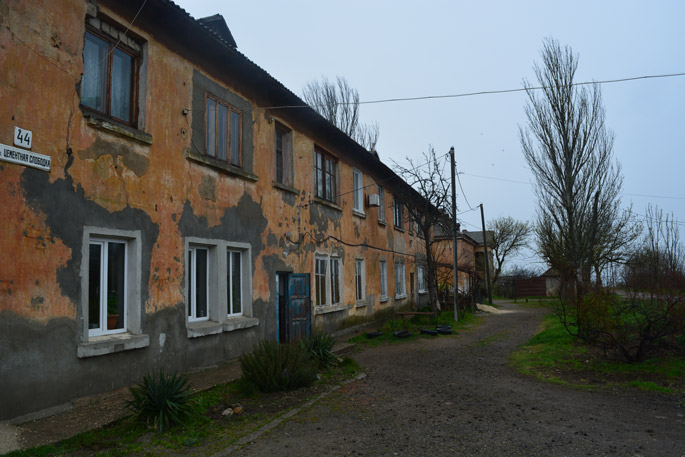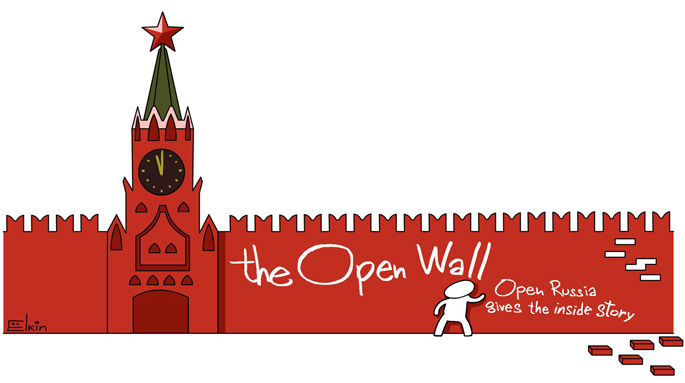“The construction project of the century”
“The construction project of the century”
Of all the mega-projects that have become a substitute for everyday well-being for Russians, the Kerch bridge is surely at the top of the list
Valentin Ostrovsky
For the sake of the “construction project of the century” – the 19-kilometre Kerch bridge, which will connect the Crimean peninsula with the Russian mainland – an entire residential area known as Cementnaya Slobodka will be torn down. Its residents, all 185 of them, are supposed to be resettled in new houses by autumn, but …
The “construction project of the century” is constantly in the news. During the recent “Direct Line with Vladimir Putin,” the jolly, smiling builders reported by video link to the president that, “Work is being done on the Kerch Peninsula, and on the Taman Peninsula, and on Tuzla. We are now pouring concrete into the second pier of the transport crossing over the Kerch Strait. The first pier is already built. As of today over 500 piles have been sunk and bored. We are at the equator of construction.” The president beamed and expressed his appreciation. But the residents of Cementnaya Slobodka are not so pleased.
“When the bridge builders were brought here, they were dumbfounded: ‘You mean you actually live here? We thought there was nothing here but a field.’” Natalia Mezhiba, a pensioner, gestures emotionally, pacing back and forth along a wooden sidewalk.
“Nothing surprising about that,” her son Mikhail adds. “After all, in the 90s they struck us out of the city’s General Plan. Like, no more Slobodka — just like that. When [Ukrainian president] Yanukovich came in 2003, you know what they did? They blocked off the road to our neighborhood with cement barriers — and told him nobody lived here.”

To “strike out” Cementnaya Slobodka, be it from a map of Kerch or from a visit by any official at all, is not a complicated matter: the neighborhood is located a couple of kilometres away from the main urban area. The houses here are old and unattractive looking: two Stalin-era two-storey buildings and some ten barracks. The residents are mostly pensioners.
“We found out that they were going to tear us down in July of last year,” says Natalia Mezhiba. “Kirichenko came from the city executive committee [deputy mayor of Kerch, Roman Kirichenko –Ed.] and said that by autumn of 2016 they’d build houses for us on Nizhny Solnechny — that’s a residential area in Kerch. At first I was happy. I mean, I would like new housing; the houses on Cementnaya Slobodka are bad — the floors have rotted through, the roofs leak, and then there’s all this construction going on that’s making all the walls shake. But then I got to thinking: what am I going to do about my livestock? You’re not going to take it with you into an apartment, after all.”
Natalia has got two cows, a bull, calves, and ten chickens. Her farm brings her income: the curds, eggs, and meat bring in 12,000 – 13,000 roubles a month. An essential supplement to a pension of eight thousand roubles ($125).
Natalia’s neighbour Valentina joins in our conversation.
“At first I didn’t want to move,” she says. “The husband and I, we refurbished the place two years ago, we installed a toilet, and now they want to tear down the house. But if everything’s going to be like the officials are promising – new houses, 15 square metres per person — then we’re okay with that.”
According to the officials’ promises, Natalia and her husband are supposed to get 40 square metres: 30 per the social norms, plus the Kerch administration is promising to add another 10 as a bonus on top of that.
“What scares me is the uncertainty,” Natalia interrupts her neighbour. “Because later we started hearing completely different information: that if they don’t build housing for us by the moment of the demolition, then they’re going to settle us in the Kerch Shipbuilding Plant dormitories. Now that’s something I’m not going to go for. Then it will be war.”
I set off to see for myself. The Stalin-era houses in Cementnaya Slobodka are considered prestigious – they’ve even got toilets inside the apartments, not out on the street like in the barracks. A blue ZAZ [vehicle produced by the Zaporozhye Automotive Plant—Ed.] stops near one of the houses. The man who steps out of the car introduces himself as Alexander.
“I don’t want to leave here,” he says. “I’ve got a two-room apartment with high ceilings; it’s been renovated. I’m a hundred metres from the sea. But on Nizhny Solnechny not only is the area not developed — there’s no store, no hospital — but it’s far to the sea from there. And besides that, there’s no clarity: have they started building the houses for us or not?
I tried to talk with deputy mayor Roman Kirichenko. in reception they explained that he’s a very busy man, and indeed is rarely even at his desk. Instead, the city administration’s press service recommended that we watch a video, in which Kirichenko tells his constituents all about the necessity of building the bridge, and tearing down their houses. It’s a great video, quite illuminating …
“How your problem is going to be resolved is something they’ll decide on the federal level, Maybe you’ll fall under the federal programme for relocation from hazardously dilapidated housing. There may be some other variants. We can say only one thing for sure: there will be a demolition and there will be a bridge. Crimea can’t support itself on its own. I very much want that those people who live in immediate proximity to the construction site be moved out right away. But in order to build a house, you need money. And there isn’t any in the city budget. Not everything depends on us.”
But not to worry – this, after all, is a flagship project. The information about how the new houses for the residents of Cementnaya Slobodka will absolutely be built in October was confirmed on 25th May by the head of the Kerch city administration himself, Sergey Pisarev. In his words, there will be two three-storey buildings with 78 apartments. Moscow has allocated 226.5 million roubles ($3.5 million) for resettling the people.
So I thought I’d go and see how they’re getting on with the building, seeing how there’s only 4 months to go before the residents will be moving in. I found myself standing in an empty field.




